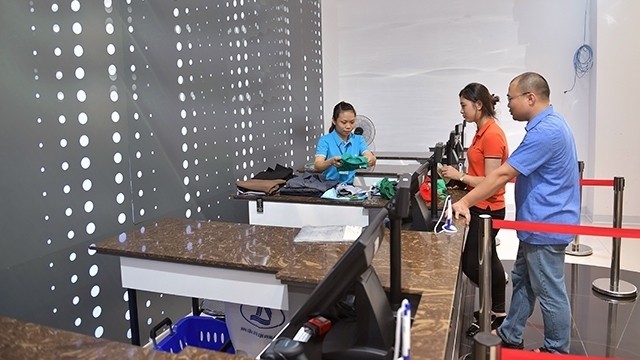Pressure from foreign "giants"
The "landing" of giant global enterprises in the fashion industry in the Vietnamese market in recent years has brought about thousands of billions of Vietnamese dong in revenue each year, which startled domestic enterprises, urging them to draw experience on business strategies. Since joining in the Vietnamese market in September 2016, the revenue of Zara Vietnam has continuously increased, from VND321 billion (US$13.80 million) after four months of operation to more than VND1,100 billion (US$47.3 million) in 2017. The company was estimated to gain a higher revenue of VND2,300 billion (US$100 million) in 2018.
Similarly, Hennes & Mauritz AB (H&M), a fashion company based in Sweden, officially launched its store in Vietnam in September 2017. After more than a year in Vietnam, H&M has expanded to six stores in Hanoi and Ho Chi Minh City. Along with the popular basic product lines, H&M has advantages in new designs and it also sells accessories at reasonable prices. In addition, the H&M in partnership with renowned designers such as Karl Lagerfeld, Balmain (Sweden) and GP& J Baker (the UK) to produce and sell fashion products. H&M does not disclose its business results in Vietnam, but it assesses Vietnam as an attractive and potential market for fashion retailers.
After Zara and H&M, Uniqlo - a famous fashion brand from Japan, is also preparing to enter the Vietnamese market in the near future, demonstrating the attractiveness of foreign fashion to Vietnamese fashion followers.
As one of the leading countries in textile and garment exports, domestic garment and textile enterprises have constantly invested in equipment and improvements to designs in a bid to increase their market share and enhance their performance. So far, several domestic apparel brands have been well received by consumers such as May 10 (Garment 10 Corporation), Viet Tien, and others.
Head of the Marketing Division of May 10, Bui Duc Thang, affirmed that Vietnam's fashion market is witnessing positive changes through breakthroughs in design and customers' fashion thinking. Understanding this demand, foreign fashion firms such as H&M, Zara, and Uniqlo are expanding their influence and gradually approaching the Vietnamese market in many different ways. This is also an opportunity for domestic textile enterprises to assess the issue scientifically based on the market's reaction to these brands to make appropriate adjustments regarding product strategy and the way to approach and serve customers.
With the advantages of distribution networks, resources and costs, May 10 is capable of competing fairly with international fashion brands. The company has recently offered a wide range of stylish and diverse fashion products in various types of materials in accordance with the current trend of Vietnamese and international fashion, with some high-end fashion products such as Eternity GrusZ, May10 M series, ECO product line or modified Ao Dai. Similarly, Chien Thang Garment Company has launched its Padu fashion line and Duc Giang Corporation introduced its fashion brands of HeraDG, Paul Downer, DGC, Dugarco Collection, and others.
Increasing localisation rate
General Director of the Vietnam National Textile and Garment Group (Vinatex) Le Tien Truong affirmed that, to expand the market share and develop the domestic market, it is necessary to carefully consider strategies in accordance with the capacity of the distribution system. The success of foreign firms does not mean that domestic firms will succeed. Foreign enterprises have advantages in finance, human resources, modern management methods, and others. Therefore, they can sell products at low prices to attract consumers. If domestic firms open new stores massively while not ensuring the quality and origin of products, they will lose prestige and customers. The domestic market is definitely important but domestic firms should cut their coat according to their cloth.
Over the past few years, Vietnam's textile and garment industry has always been proud to be one of the top three exporters of textiles and garments in the world. However, domestic enterprises seem to vacate their home market and give up the market to foreign fashion firms. Being aware of the problem, in the past few years, domestic enterprises have constantly boosted their investments and improved technology while creating new samples to enhance the added value of each product.
Chairman of the Vietnam Textile and Apparel Association (Vitas) Vu Duc Giang said that Vietnam currently has 158 domestic garment brands and most of them are aware of the value of brands and packaging added to products and are not dependent on foreign brands. The Vietnamese textile and garment industry is also gradually raising the localisation rate and focusing on developing the domestic market, including the participation in the programme "Vietnamese people prioritise using Vietnamese goods" and programmes to bring textile products to industrial zones. Furthermore, the industry has taken the initiative in devising development strategies and calling for investments in the segment that Vietnam faces shortages. In addition, the domestic textile industry has promoted the training of resources to meet the requirement from the industrial revolution 4.0 and the increasing demands of the domestic and international fashion industry.
A representative from Vinatex said that the group has been continuously responding to the campaign "Vietnamese people prioritise using Vietnamese goods" through practical actions. Vinatex not only calls for its member units to participate in the campaign and develop long-term strategies in the domestic market, it also signs deals with other corporations to support each other and use each other's products.
Thanks to its considerable efforts, the total domestic revenue of Vinatex reached more than VND12,638 billion (US$543.43 million) in 2018, up 22.58% compared to 2017. However, in order to make apparel products win the heart of the people, it requires the attention and support of relevant ministries and sectors regarding the removal of difficulties in export procedures, reduction of administrative procedures, cumbersome rules and regulations on bidding, and incentives in tax and fees so that businesses find it easy to connect and use each other's products.
















